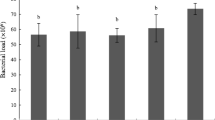Summary
Although moisture requirements of Eisenia fetida are considered to be generally known, very few in-depth studies have been performed. The moisture preferences of juveniles as well as adults of this species were determined in moisture towers containing cow manure with a particle size bigger than 500 and smaller than 1000 μm and an organic matter content of 54%. The clitellate worms showed a wider preference range than the juveniles but deposited most of their cocoons within the narrow range of 65%–70% moisture — a moisture range preferred by 80% of the juveniles. Growth studies of newly hatched worms at various moisture levels over a period of 90 days showed that growth rate and final biomass were influenced by moisture availability with a very low rate of growth at low as well as at high moisture levels. The change in biomass of clitellate specimens as well as their consecutively produced cocoons were monitored at different moisture levels. A clear relationship between mass of cocoons and biomass of the producing worms was established at presumably favourable moisture conditions. Furthermore, the relation between cocoon mass and the production rate of cocoons was also determined, which showed that cocoon mass increased concomitantly with increase in cocoon production. The study also showed that clitellum development was increased at moisture levels above 64%. The onset of cocoon production was, however, earliest at slightly lower moisture levels, from which it is concluded that the optimal moisture level for growth and development of clitella are not necessarily optimal for the production of cocoons.
Similar content being viewed by others
References
Abrahamsen G (1971) The influence of temperature and soil moisture on the population density of Cognettia sphagnetorum (Oligochaeta: Enchytraeidae) in cultures with homogenized raw humus. Pedobiologia 11:417–424
Edwards CA, Lofty JR (1977) Biology of earthworms. Chapman and Hall, London
Evans AC, Guild WJ McL (1948) Studies on the relationships between earthworms and soil fertility. IV. On the life cylces of some British Lumbricidae. Appl.Biol 35:471–483
Graff O (1974) Gewinnung von Biomasse aus Abfallstoffen durch Kultur des Kompostregenwurms Eisenia foetida (Savigny 1826). Landbauforsch Völk 24:137–142
Grant WC (1955) Studies on moisture relationships in earthworms. Ecology 36:400–407
Hartenstein R, Neuhauser EF, Kaplan DL (1979) Reproductive potential of the earthworm Eisenia foetida. Oecologica 43:329–340
Hartenstein R (1981) Use of Eisenia foetida in organic recycling based on laboratory experiments. In: Appelhof M (ed) Workshop on the role of earthworms in the stabilization of organic residues. Beech Leaf, Kalamazoo, Michigan, pp 155–165
Kaplan DL, Hartenstein R, Neuhauser EF (1980) Physicochemical requirements in the environment of the earthworm Eisenia foetida. Soil Biol Biochem 12:347–352
Neuhauser EF, Hartenstein R, Kaplan DL (1979) Second progress report on the potential use of earthworms in sludge management. Proc 8th National Sludge Conference. Information Transfer Inc., Silver Springs Md
Neuhauser EF, Kaplan DL, Malecki MR, Hartenstein R (1980) Material supporting weight gain by the earthworm Eisenia fetida in waste conversion systems. Agric Wastes 2:43–60
Reinecke AJ, Ryke PAJ (1970) On the water relations of Microchaetus modestus (Microchaetidae, Oligoehaeta) Wet Bydraes PU vir CHO, Potchefstroom, RSA, B no 15
Reinecke AJ, Kriel JR (1981) Influence of temperature on the reproduction of the earthworm Eisenia foetida (Oligochaeta). S Aft J Zool 16:96–100
Reinecke AJ, Venter JM (1885a) Dieldrin and growth and development of the earthworm Eisenia fetida (Oligochaeta). Bull Environ Contam Toxicol 35:652–659
Reinecke AJ, Venter JM (1985b) Influence of moisture on the growth and reproduction of the compost worm Eisenia fetida (Oligochaeta). Rev Ecol Biol Sol 22:473–481
Roots BI (1956) The water relations of earthworms II. Resistance to desiccation and immersion, and behaviour when submerged and when allowed a choice of environment. J Exp Biol 33:29–44
Satchell JE (1981) Earthworm evolution: Pangaea to production prototype. In: Appelhof M (ed) Workshop on the role of earthworms in the stabilization of organic residues. Beech Leaf, Kalamazoo, Michigan, pp 3–35
Schulz E, Graff O (1977) Zur Bewertung von Regenwurmmehl aus Eisenia foetida (Savigny 1826) als Eiweissfuttermittel. Landbauforsch Völk 27:216–218
Tomlin AD, Miller JJ (1980) Development and fecundity of the manure worm Eisenia foetida (Annelida: Lumbricidae) under laboratory conditions. In: Dindal DL (ed) Soil biology as related to land use practices. Proc 7th Internat Soil Zool Coll of ISSS. EPA, Washington DC, pp 673–678
Tsukamoto J, Watanabe H (1977) Influence of temperature on hatching and growth of Eisenia foetida. Pedobiologia 17:338–342
Vail VA (1974) Contributions on North American earthworms (Annelida II. Observations on the hatchlings of Eisenia foetida and Bimastos tumidus (Oligochaeta: Lumbricidae). Bull Tall Timbers Res Sta 16:1–8
Author information
Authors and Affiliations
Additional information
Dedicated to the late Prof. Dr. M.S. Ghilarov
Rights and permissions
About this article
Cite this article
Reinecke, A.J., Venter, J.M. Moisture preferences, growth and reproduction of the compost worm Eisenia fetida (Oligochaeta). Biol Fert Soils 3, 135–141 (1987). https://doi.org/10.1007/BF00260595
Received:
Issue Date:
DOI: https://doi.org/10.1007/BF00260595




